Physical Address
304 North Cardinal St.
Dorchester Center, MA 02124
On completion of this chapter, you should be able to:
Describe the development and normal anatomy of the umbilical cord
Predict obstetric problems that may be associated with abnormal umbilical cord dimensions
Discuss the umbilical cord disorders presented in this chapter, including causes and clinical significance
Differentiate how the sonographer may distinguish tumors and cysts from a true knot in the umbilical cord
The umbilical cord is the essential link for oxygen and important nutrients for the fetus, the placenta, and the mother. The amnion covers the cord and blends with the fetal skin at the umbilicus. The umbilical cord comprises two arteries and one vein surrounded by gelatinous stroma. Vascular connections within the cord serve a reverse function in the fetus; the vein carries oxygenated blood to the fetus, whereas the two arteries bring venous blood back to the placenta.
The umbilical cord can be clearly visualized with sonography from the eighth gestational week until term. The amniotic membrane covers the fetal surface of the placenta and the multiple vessels that branch from the umbilical vein and arteries. The cord should normally insert into the center of the placenta.
The umbilical cord forms during the first 5 weeks of gestation (7 menstrual weeks) as a fusion of the omphalomesenteric (yolk stalk) and allantoic ducts ( Fig. 57.1 ). An outpouching from the urinary bladder forms the urachus, which projects into the connecting stalk to form the allantois. The allantoic vessels become the definitive umbilical vessels. The umbilical cord acquires its epithelial lining as a result of enlargement of the amniotic cavity and envelopment of the cord by the amniotic membrane. The intestines grow at a faster rate than the abdomen; they herniate into the proximal umbilical cord at approximately 7 weeks and remain there until approximately 10 weeks. The insertion of the umbilical cord into the ventral abdominal wall is an important sonographic anatomic landmark because scrutiny of this area will reveal abdominal wall defects, such as omphalocele, gastroschisis, or limb–body wall complex.
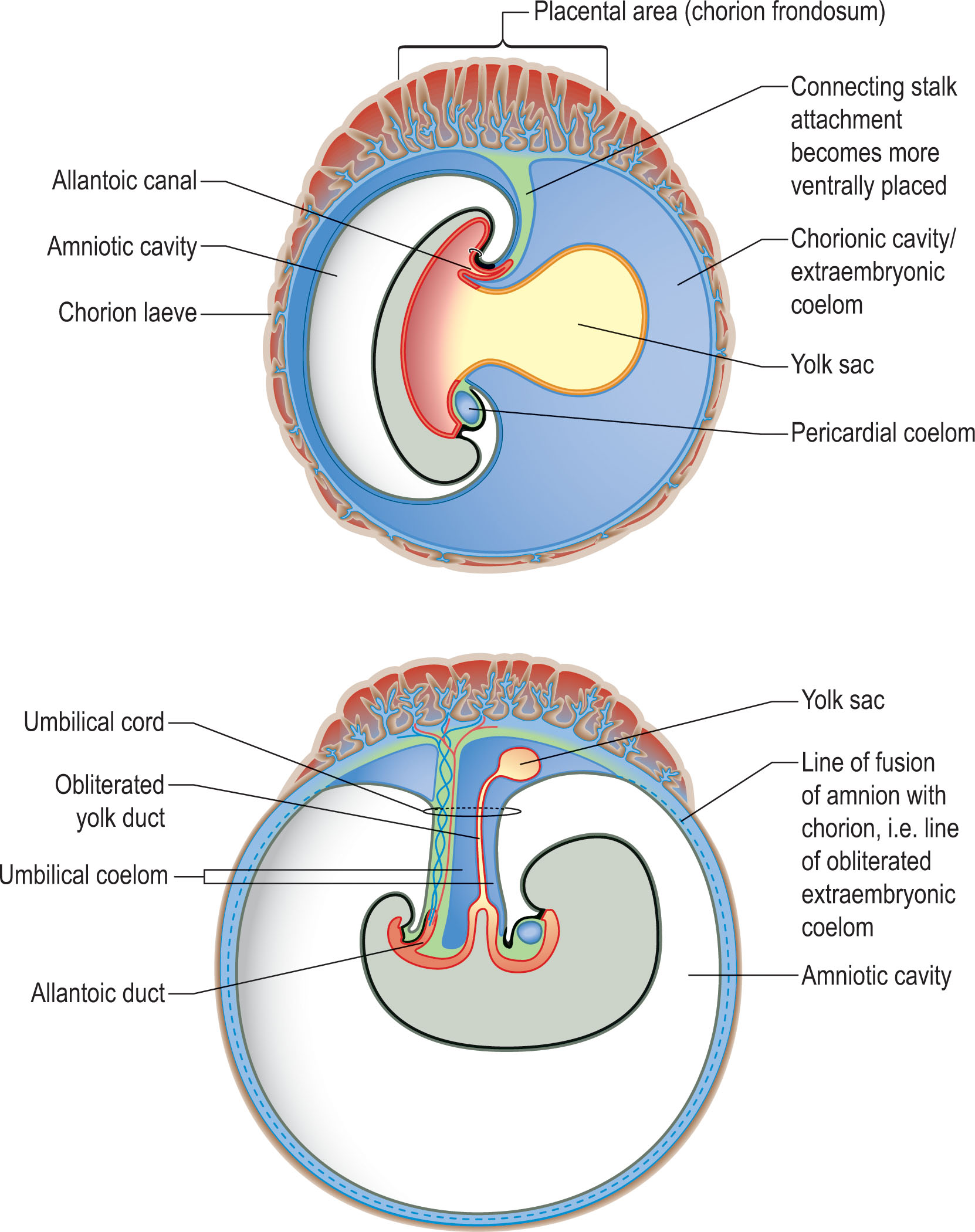
The umbilical cord is covered by the amniotic membrane. The cord includes two umbilical arteries and one umbilical vein ( Fig. 57.2 ) and is surrounded by a homogeneous substance called Wharton jelly. Wharton jelly is a myxomatous connective tissue that varies in size and may be imaged with high-frequency ultrasound transducers. The diameter of the cord usually measures 1 to 2 cm (variations in cord diameter are usually attributed to Wharton jelly). The normal length of the cord is 40 to 60 cm; it is difficult to assess the length reliably with ultrasound.
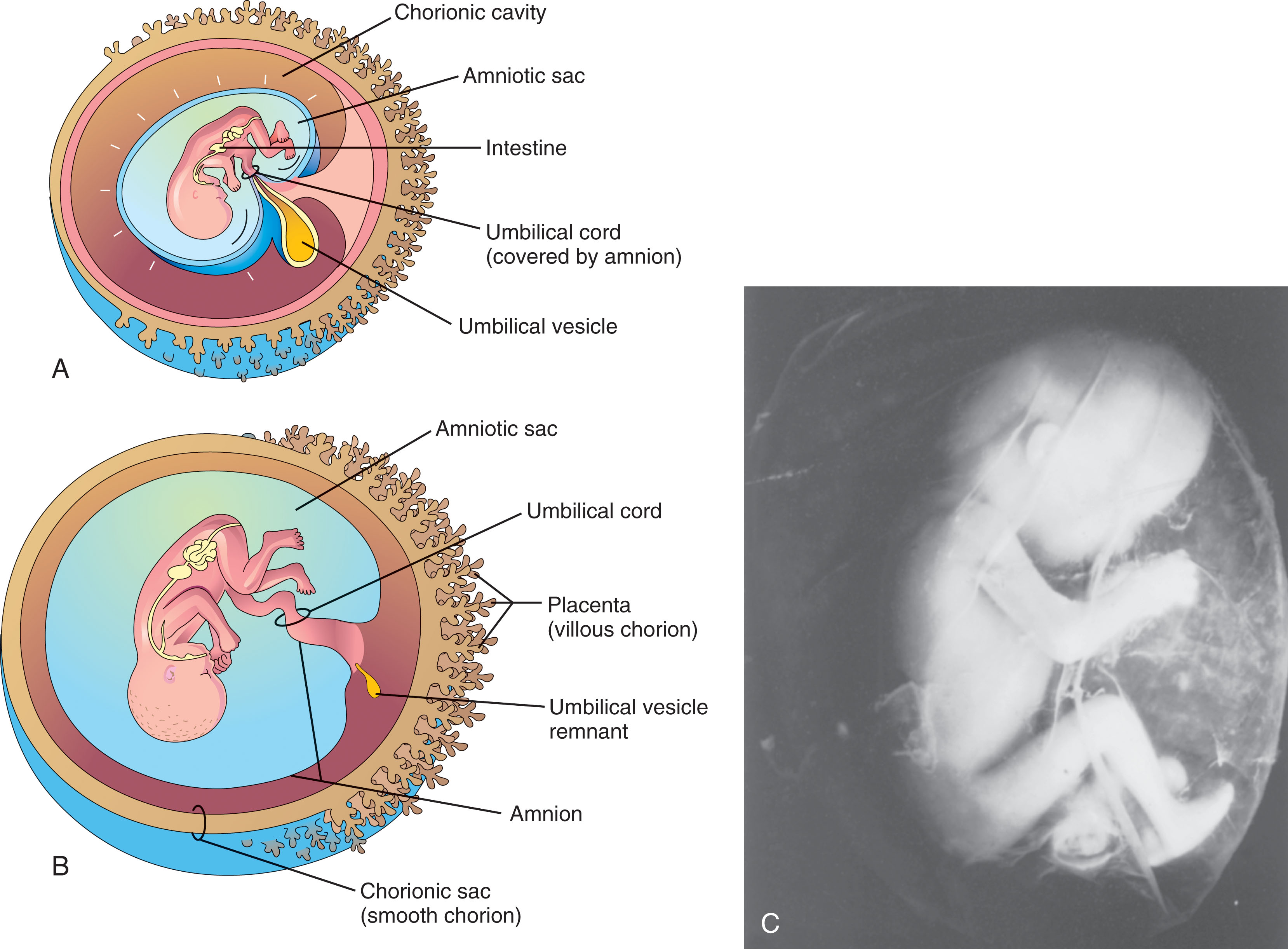
The umbilical arteries arise from the fetal internal iliac arteries, course alongside the fetal bladder, and exit the umbilicus to form part of the umbilical cord. The paired umbilical arteries course along the entire length of the cord in a helicoidal fashion surrounding the umbilical vein. The umbilical arteries branch along the chorionic plate of the placenta.
The umbilical vein is formed by the confluence of the chorionic veins of the placenta, with its primary purpose to transport oxygenated blood back to the fetus. The umbilical vein enters the umbilicus and joins the left portal vein as it courses through the liver. The intraabdominal portions of the umbilical vessels degenerate after birth; the umbilical arteries become the lateral ligaments of the bladder, and the umbilical vein becomes the round ligament of the liver.
The umbilical cord has one large vein and two smaller arteries ( Fig. 57.3 ). The umbilical vein transports oxygenated blood from the placenta, and the paired umbilical arteries return deoxygenated blood from the fetus to the placenta for purification. The umbilical cord is identified at the cord insertion into the placenta and at the junction of the cord into the fetal umbilicus ( Fig. 57.4 ). The arteries spiral with the larger umbilical vein, which is surrounded by Wharton jelly. Absent cord twists may be associated with decreased fetal movement and a poor pregnancy outcome ( Fig. 57.5 ).

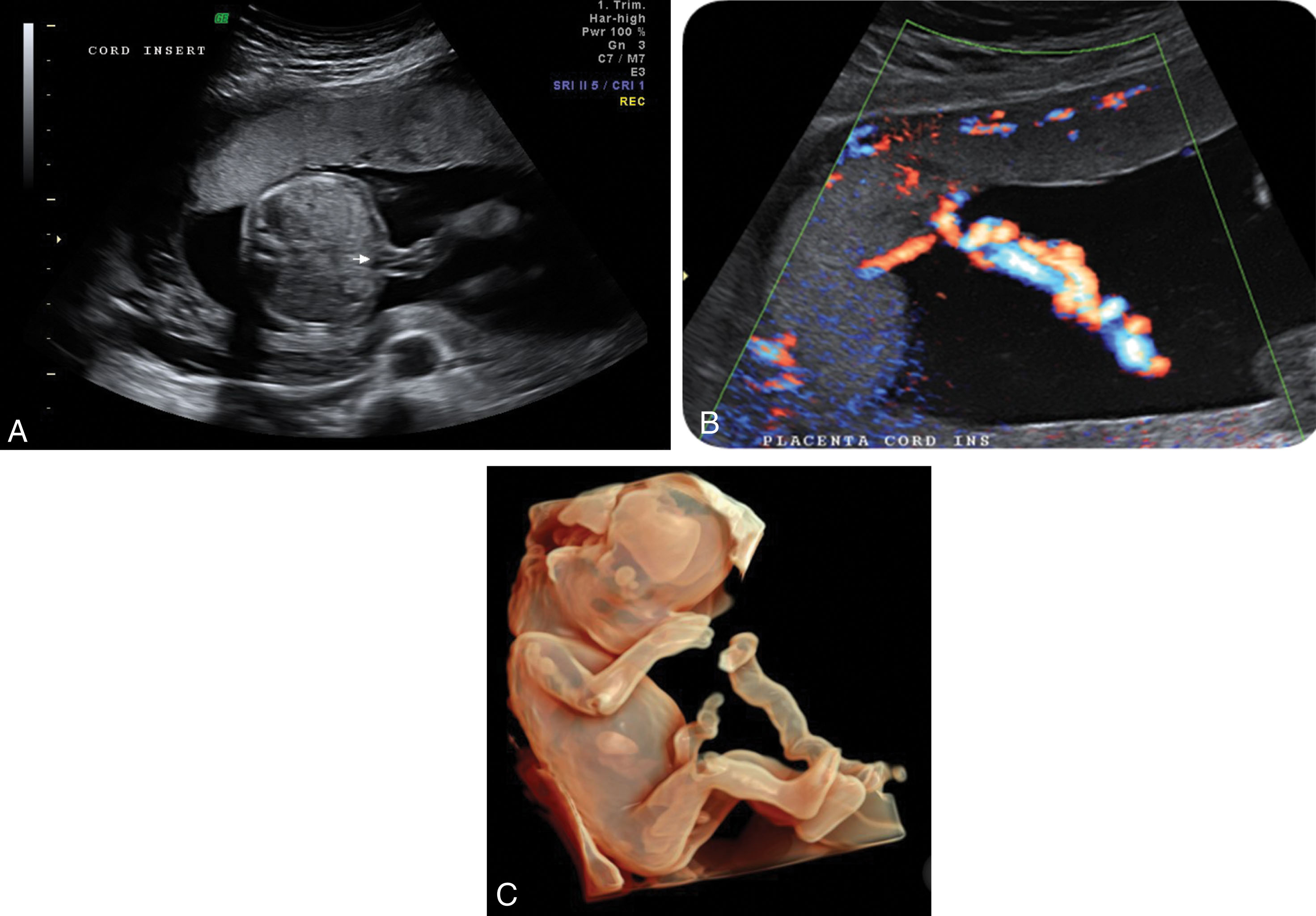
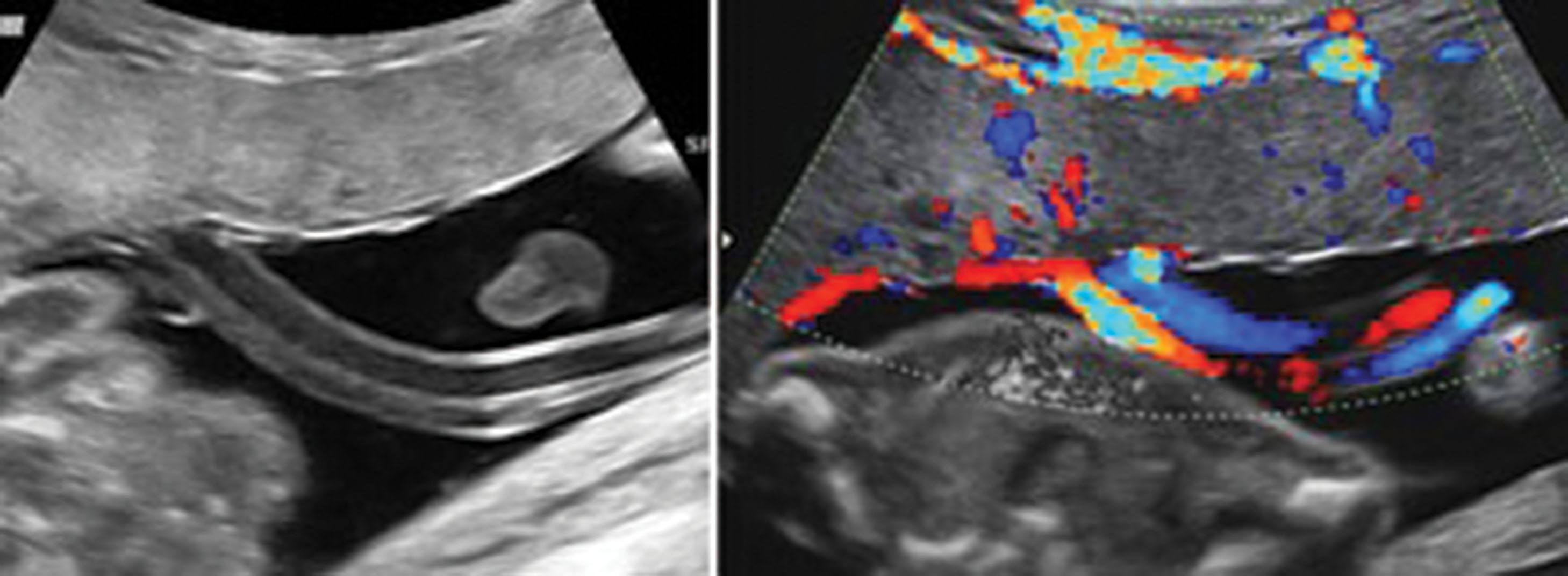
In the second and third trimesters, the two arteries and the vein can be clearly seen. The number of umbilical arteries can be distinctly identified and should be documented. The three vessels of the cord may be followed with real-time ultrasound as they enter the abdomen and travel toward the liver and iliac arteries ( Fig. 57.6 ). From the left portal vein, umbilical blood may flow through the ductus venosus to the systemic veins (inferior vena cava or hepatics), bypassing the liver, or through the right portal sinus to the right portal vein. The ductus venosus forms the conduit between the portal system and the systemic veins.
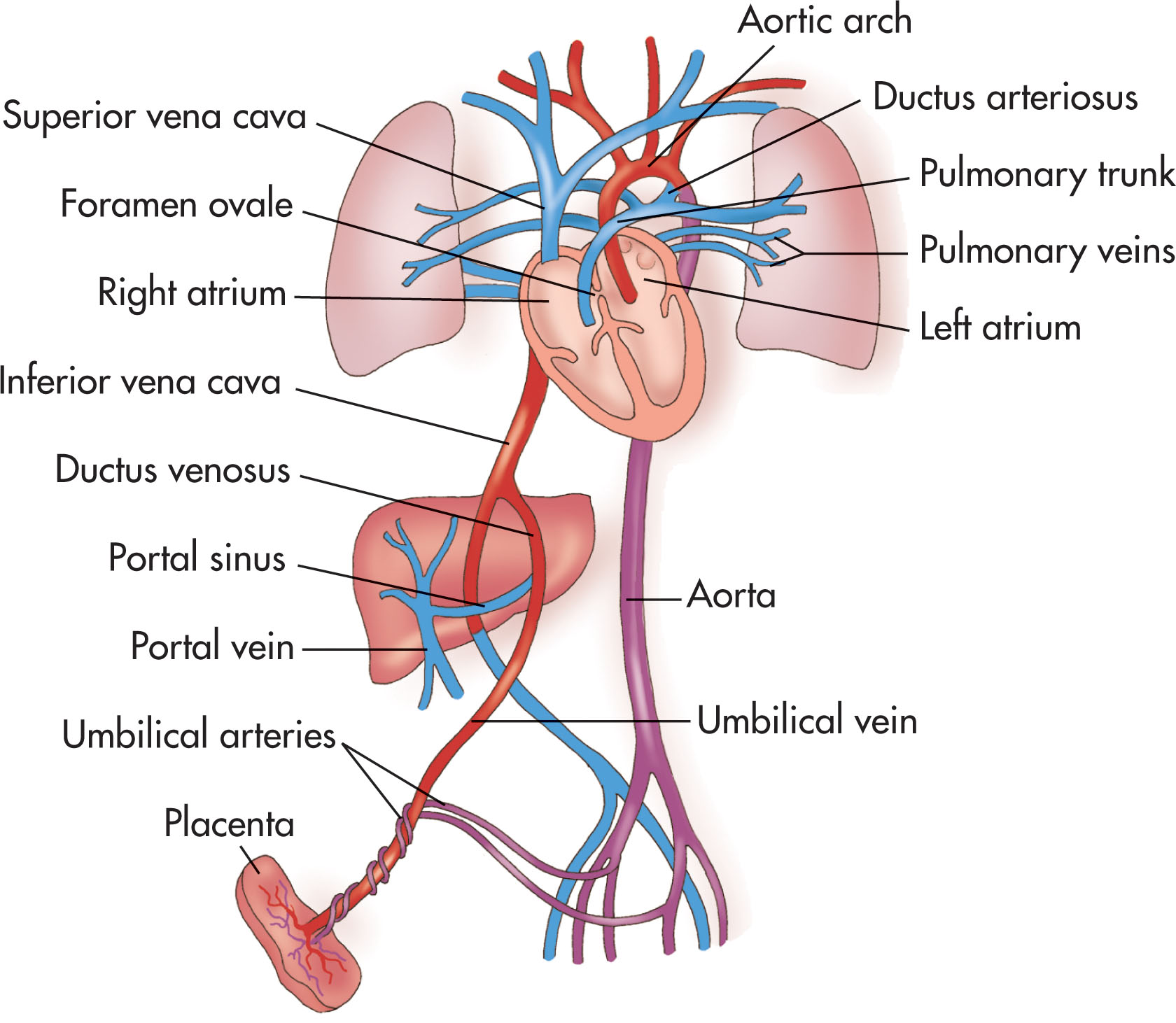
Sonographically, the ductus venosus appears as a thin intrahepatic channel with echogenic walls. ( Fig. 57.7 ) It lies in the groove between the left lobe and the caudate lobe. The ductus venosus is patent during fetal life until shortly after birth, when transformation of the ductus into the ligamentum venosum occurs in the second week after birth.
![Fig. 57.7, From the left portal vein, umbilical blood may flow through the ductus venosus to the systemic veins (inferior vena cava [IVC] or hepatics), bypassing the liver, or through the right portal sinus to the right portal vein. The ductus venosus forms the conduit between the portal system and the systemic veins. Sonographically, the ductus venosus appears as a thin intrahepatic channel with echogenic walls. It lies in the groove between the left lobe and the caudate lobe. Ao , Aorta; DV , ductus venous; IVC , inferior vena cava; LPV , left portal vein; St , stomach; UV , umbilical vein. Fig. 57.7, From the left portal vein, umbilical blood may flow through the ductus venosus to the systemic veins (inferior vena cava [IVC] or hepatics), bypassing the liver, or through the right portal sinus to the right portal vein. The ductus venosus forms the conduit between the portal system and the systemic veins. Sonographically, the ductus venosus appears as a thin intrahepatic channel with echogenic walls. It lies in the groove between the left lobe and the caudate lobe. Ao , Aorta; DV , ductus venous; IVC , inferior vena cava; LPV , left portal vein; St , stomach; UV , umbilical vein.](https://storage.googleapis.com/dl.dentistrykey.com/clinical/TheUmbilicalCord/6_3s20B9780323826464000573.jpg)
The umbilical arteries may be followed caudally from the cord insertion, in their normal path adjacent to the fetal bladder, to the iliac arteries. On sonography, the sonographer may look at the cord in a transverse plane to see one large umbilical vein and two smaller umbilical arteries. Another sonographic approach to viewing the arteries is to look lateral to the fetal bladder in a transverse or coronal plane. The umbilical arteries run along the lateral margin of the fetal bladder and are well imaged with color flow Doppler ( Fig. 57.8 ). In the postpartum stage, the umbilical arteries become the superior vesical arteries .

Although the umbilical cord varies normally in length and width, researchers have found specific problems associated with a cord that varies from standard dimensions. In the first trimester, the length is approximately the same as the crown-rump length. The normal cord measures 40 to 60 cm in length and is difficult to measure reliably with sonography ( Fig. 57.9 ).
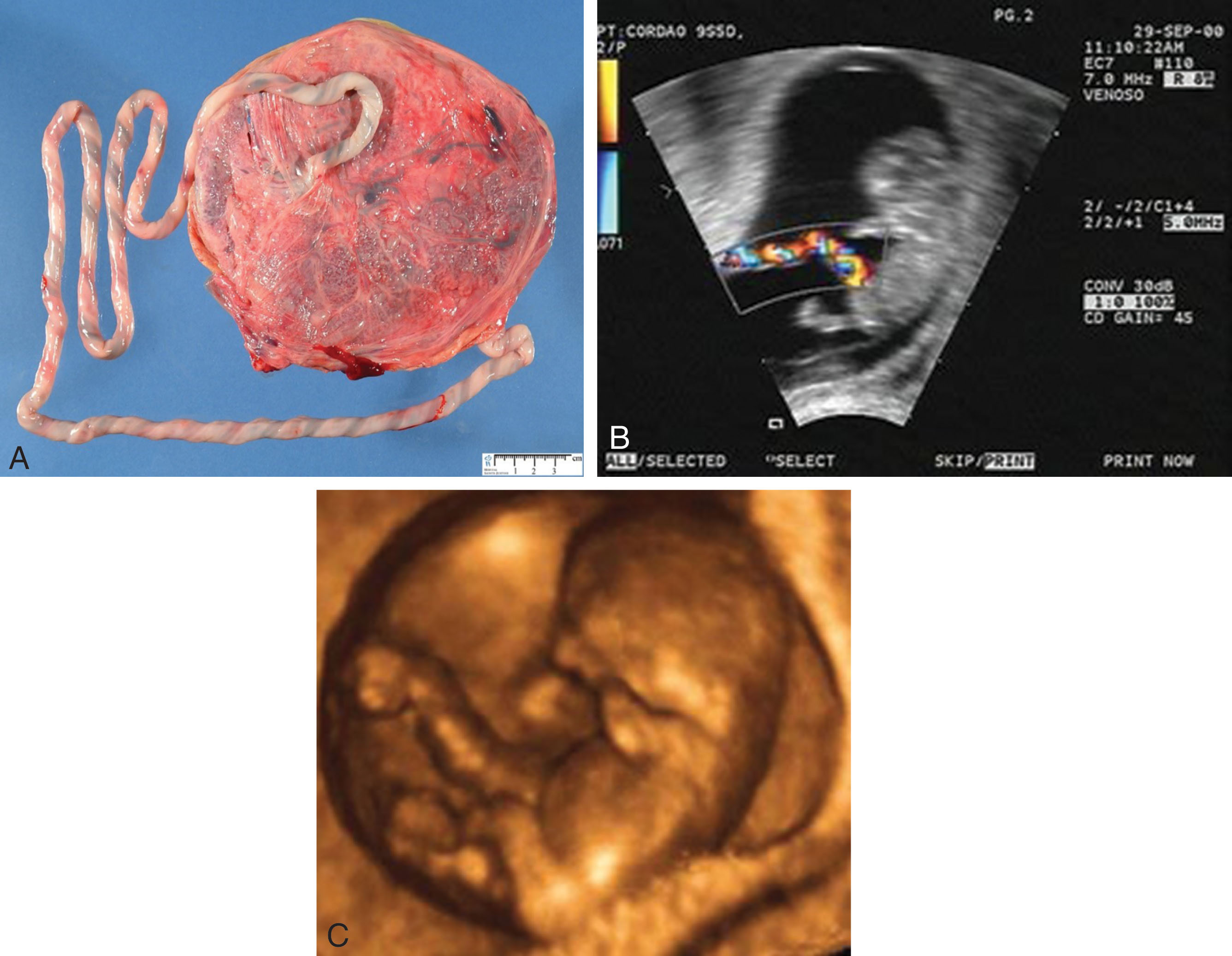
A short umbilical cord measures less than 35 cm in length. This condition is associated with or is predisposed to the following:
Oligohydramnios
Restricted space (as in multiple gestations)
Intrinsic fetal anomaly
Tethering of the fetus by an amniotic band
Inadequate fetal descent
Cord compression
Fetal distress
Coiling of the umbilical cord is normal and is related to fetal activity. The normal cord may coil as many as 40 times, usually to the left and near the fetal insertion site. The helical twisting of the cord can be easily determined by gross pathologic inspection. With the cord held vertically, vessels along the anterior surface that spiral downward from high left to low right, angled like the left side of the letter V, indicate a left helix ( Fig. 57.10A ). The incidence of a “left” twist of the cord in pregnancy is found at a rate of 7:1. The significance of this is that a fetus with a “right” twist in the cord has a higher incidence of fetal anomalies than one with a left twist ( Fig. 57.10C ).

The absence of cord twisting is an indirect sign of decreased fetal movement ( Fig. 57.11 ). This event occurs in a small (4.3%) number of deliveries; however, it may lead to increased mortality and morbidity. Other obstetric problems seen with a short umbilical cord include preterm delivery, decreased heart rate during delivery, meconium staining secondary to fetal distress, and fetal anomalies. If the cord is completely atretic and the fetus is attached directly to the placenta at the umbilicus, an omphalocele is always present.
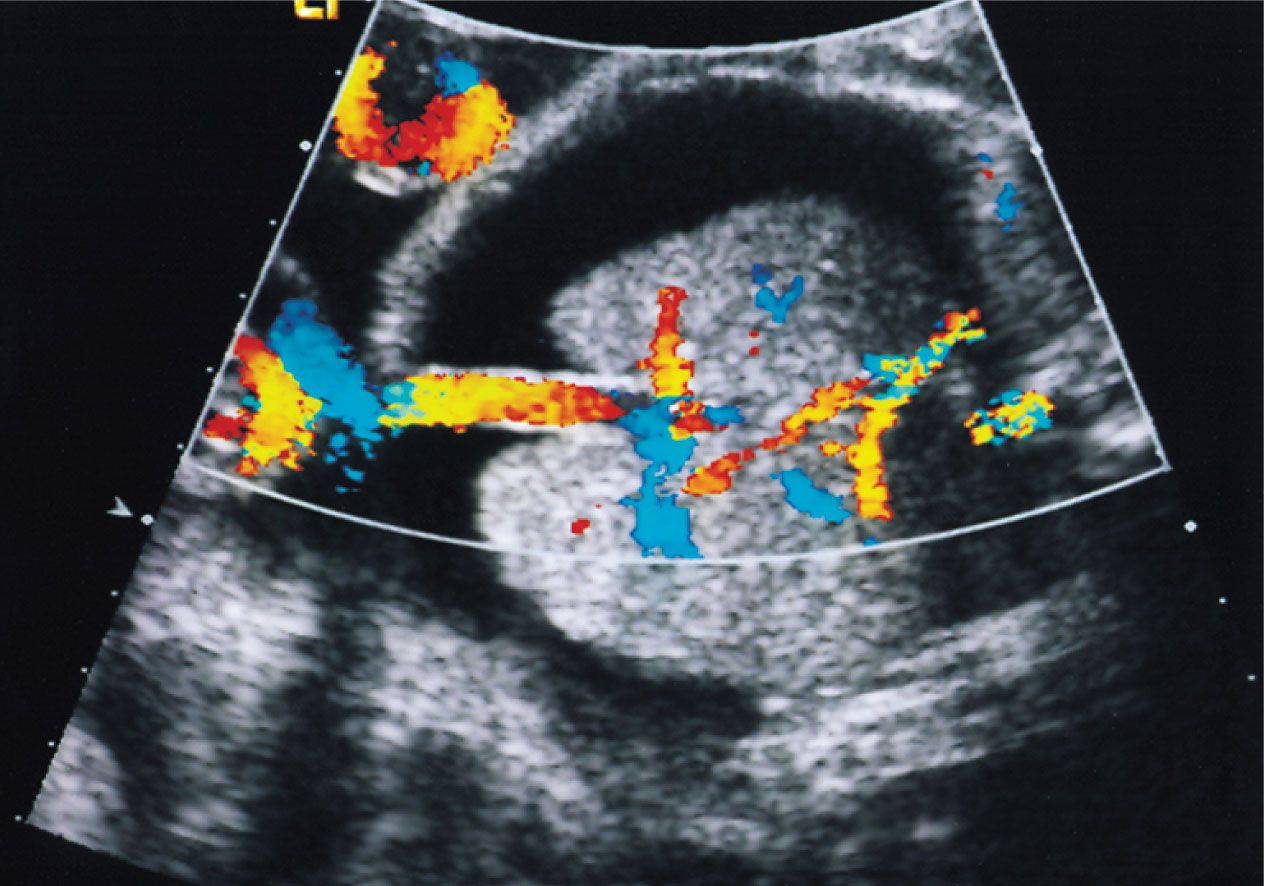
It has been theorized that the length of the umbilical cord is determined in part by the amount of amniotic fluid present in the first and second trimesters, and in part by fetal mobility. Therefore, the presence of oligohydramnios, amniotic bands, or limitation of fetal movement for any reason may impede umbilical cord growth.
A long umbilical cord measures longer than 80 cm and may be associated with or predisposed to the following:
Polyhydramnios
Nuchal cord (occurs in 25% of deliveries)
True cord knots (occur in 0.5% of deliveries); may be difficult to distinguish from “false” cord knot or redundancy of cord; true knots cause vascular compromise and fetal demise
Umbilical cord compression, cord presentation, and prolapse of the cord leading to fetal distress
Umbilical cord stricture or torsion resulting from excessive fetal motion
The diameter of the umbilical cord measures from 2.6 to 6.0 cm. Variations in cord diameter are usually attributed to diffuse accumulation of Wharton jelly. This condition has been associated with maternal diabetes, edema secondary to fetal hydrops, Rh incompatibility, and fetal demise.
Umbilical cord masses are not very common in the fetus. Many of the “masses” seen on ultrasound may be attributed to focal accumulation of Wharton jelly and may be isolated or associated with an omphalocele or cyst. Cystic masses in the cord are usually omphalomesenteric or allantoic in origin. These are generally small (less than 2 cm), tend to occur near the fetal end of the cord, and resolve by the second trimester. Cysts that persist beyond the first trimester usually are associated with other fetal anomalies and aneuploidy.
Other masses associated with the umbilical cord include the following:
Omphalocele (cord runs through the middle of this mass as it protrudes from the umbilicus)
Gastroschisis (mass is usually found to the right of this cord)
Umbilical herniation
Teratoma of the umbilical cord
Aneurysm of the cord
Varix of the cord (may be intraabdominal)
Hematoma of the cord (usually iatrogenic—cordocentesis or amniocentesis)
True knot of the cord
Angioma of the cord (well-circumscribed echogenic mass that may cause increased cardiac failure and hydrops; alpha-fetoprotein level is increased; associated with a cyst caused by transudation of fluid from a hemangioma)
Thrombosis of cord secondary to compression or kinking, focal cord mass, true cord knots, velamentous cord insertion, or cord entanglement in monoamniotic twins (commonly seen with fetal demise)
Omphalocele occurs 1 in 5000 births and results from failure of the intestines to return to the abdomen. The omphalocele is categorized on whether the sac contains liver or only bowel. This hernia may consist of a single loop of bowel, or it may contain most of the intestines ( Fig. 57.12 ). The covering for the hernia sac consists of epithelium derived from the parietal peritoneum and amnion. The umbilical cord inserts into the base of the omphalocele sac.
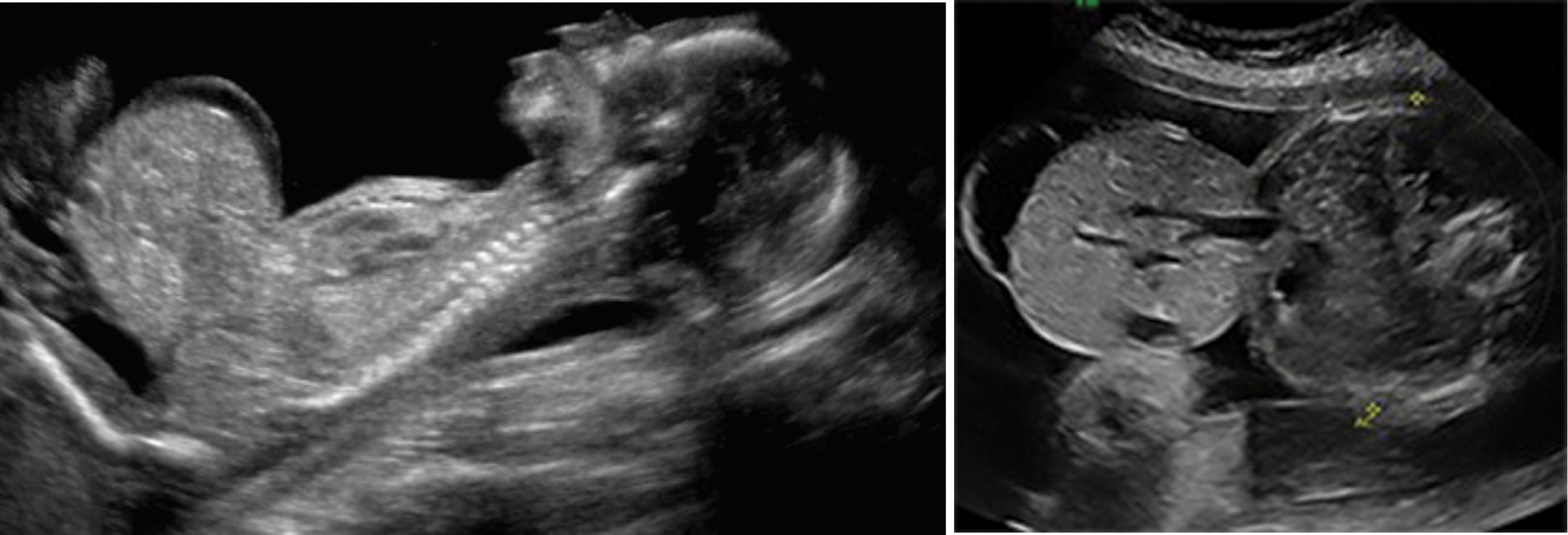
There is a strong association of omphalocele with aneuploidy; more than half of the fetuses with omphaloceles have additional malformations and chromosomal abnormalities. Trisomy 18 is the most common associated aneuploidy, followed by trisomy 13.
Gastroschisis is usually a right paraumbilical defect involving all layers of the abdominal wall and usually measuring 2 to 4 cm. The small bowel always eviscerates through the defect ( Fig. 57.13 ). The loops of bowel are never covered by a membrane; thus they are directly exposed to amniotic fluid and elevated alpha-fetoprotein levels. Other organs that may eviscerate are large bowel, stomach, a portion of the gastrointestinal system, and, rarely, liver.
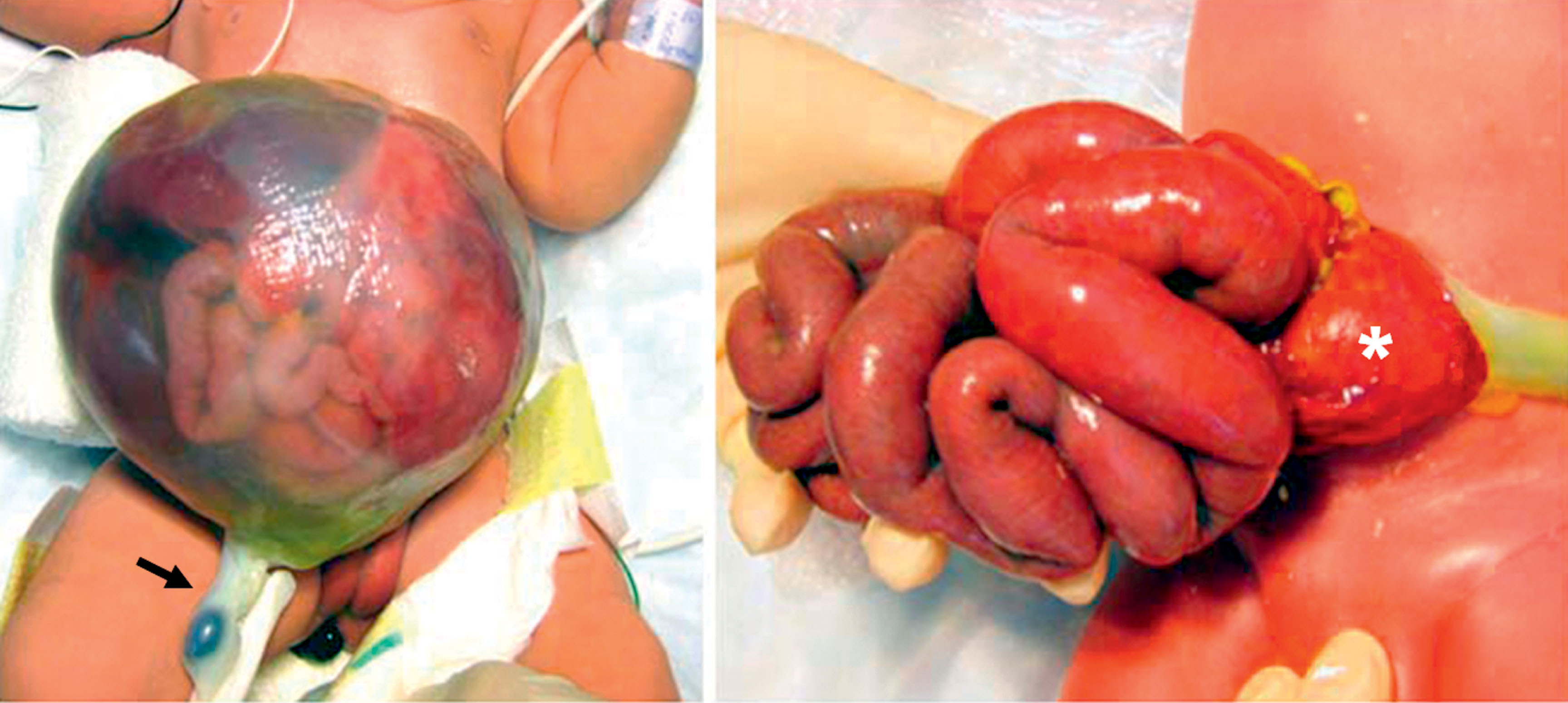
Become a Clinical Tree membership for Full access and enjoy Unlimited articles
If you are a member. Log in here